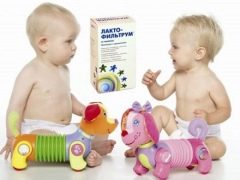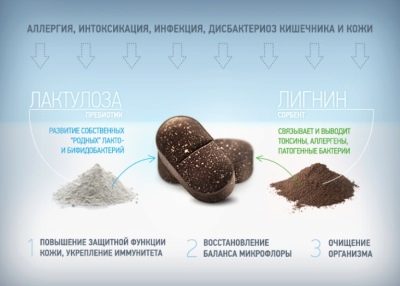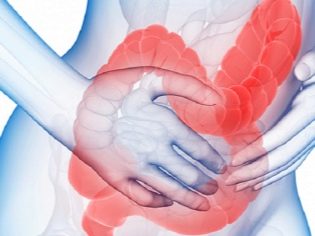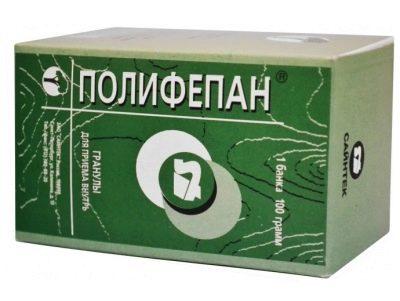Laktofiltrum for children: instructions for use
Preparations from the group of enterosorbents used in various bowel diseases, manifestations of allergy, poisoning and other pathologies. One of the modern tools from such a group is Laktofiltrum. Due to the two-component composition, it not only adsorbs toxic substances, but also has a positive effect on digestion. Is it possible to use it in children and what doses are allowed for children, we find out in this article.
Release form and composition
"Laktofiltrum" is available only in one dosage form, which are tablets. They have a capsule shape, convex on both sides, and there is a risk in which the tablet can be divided into halves. The color of this drug is dark brown, but in the structure of the tablets there are splashes of white-gray color. The drug is placed in blister packs of 10–15 pieces or in plastic jars and sold for 30 or 60 tablets in one box.
The action of the drug due to a combination of two active ingredients. One of them is hydrolytic lignin, which is extracted from wood. His dose, if you count the amount of dry matter, is 355 mg in each tablet. The second active ingredient "Lactofiltrum" is a synthetic disaccharide called lactulose. The amount of this ingredient per tablet is 120 mg.
Among the inactive components of the medicament are microcrystalline cellulose and croscarmellose sodium, as well as magnesium stearate. Such substances are added to the preparation in order to obtain a dense tablet and give it the desired shape.
Operating principle
The manufacturer calls “Lactofiltrum” an innovative medicine for its dual effect. Under the influence of lactulose in its composition, the growth of intestinal flora is stimulated, and lignin, due to its significant sorption surface, helps to neutralize toxins, allergens and pathogenic bacteria. In addition, both pill ingredients have a positive effect on the patient’s immunity, enhancing non-specific protection.
With the inclusion of this drug in the complex treatment of skin diseases, a decrease in hyperemia and infiltration, the elimination of itching and dryness is observed.
Indications
Use of "Laktofiltrum" is claimed:
- in violation of the intestinal microflora;
- with irritable bowel syndrome;
- with acne, hives, atopic dermatitis and other skin diseases, in which there is dryness, rash, itching or scaling;
- with hepatitis or cirrhosis of the liver;
- with reduced immunity;
- rotavirus, giardiasis and various infections that affect the intestines;
- from infant colic.
From what age is prescribed?
Treatment with Laktofiltrum is allowed for children older than 1 year.
If a sorbent is required for a newborn or infant, the doctor will recommend one of the analogues approved from birth.
Contraindications
The use of "Laktofiltrum" is prohibited:
- children who are hypersensitive to any pill ingredient;
- patients with intestinal obstruction;
- children diagnosed with galactosemia;
- in a situation where there is a risk of gastrointestinal bleeding or it has already begun;
- if the patient has a gastrointestinal ulcers;
- children with intestinal atony.
Side effects
Taking Laktofiltrum, like any other medicine, can cause a skin rash or other allergic reaction. Occasionally the drug provokes flatulence or diarrhea.
Regimen
Laktofiltrum is taken three times a day. The duration of use should be clarified with the doctor, but the average course of treatment is 2-3 weeks. The pill is given to the child whole, and if it has difficulty swallowing (for example, when the crumbs are only a year old or 2), the medicine is allowed to be pre-crushed.
Wash down the drug should be plain water. So that it does not affect the intake of any other drugs or the absorption of nutrients from food, it is recommended to give Lactofiltrum to young patients an hour before taking other medicines and before feeding.
Single doses depend on the age of the child:
- if he is from 1 to 3 years old, then only one half tablet is enough for one dose;
- for preschool children of 3–7 years of age, one tablet is a single dosage of “Lactofiltrum”;
- children 8–12 years old can take the medication either one at a time or two tablets at a time;
- if the patient is more than 12 years old, he should take 2-3 tablets at once.
Overdose and drug interactions
Taking too many pills can cause abdominal pain and constipation. To eliminate these symptoms, “Lactofiltrum” should be canceled, and the patient's condition will soon return to normal.
As for compatibility with other drugs, then, as mentioned above, “Laktofiltrum” should not be given at the same time with any other drugs, as the tablets will reduce their therapeutic effect.
To avoid such influence, it is recommended to take a break between taking different drugs for at least 1 hour. With this separate use, Lactofilter can be combined with any drugs, including antibiotics.
Terms of sale and storage
Buying pills at the pharmacy is usually not difficult, because Laktofiltrum refers to over-the-counter drugs and is manufactured by a Russian company. The average price of 30 tablets is 270–280 rubles, and for a package containing 60 tablets, you need to pay about 380–420 rubles.
The shelf life of the drug is 3 years from the date of manufacture, which should be clarified on the box or in the instructions for use before taking Laktofiltrum, in order not to accidentally give the child an expired medication.
While this period has not expired, tablets should be stored at a temperature not higher than +30 degrees in a dry place where children will not get them.
Reviews
On the application of “Laktofiltrum” they respond mostly well, calling such tablets effective and harmless. According to moms, the drug is convenient to use, has a neutral taste and is well tolerated, improving digestion and helping with skin manifestations of allergies. Of the minuses, in some cases they call it overpriced, since there are quite a few analogues cheaper. Also in single cases, the drug gave negative side effects, because of which it had to be canceled.
Analogs
Completely similar to “Laktofiltrum” drugs are not released, but if necessary, replace The doctor usually chooses such tablets with similar preparations among other enterosorbents.
- «Enterosgel». Such a gel-like paste has strong sorbing properties due to a special porous matrix. Drug without taste is allowed from birth, and sweet paste can be used in children older than a year.
- «Smecta». The effect of this known sorbent is provided by smectite, which has a natural origin. The drug is considered effective and safe, therefore, prescribed from birth for vomiting, diarrhea, bloating, allergies and in other cases. Moms also like its portioned form, as Smekta is sold in sachets, inside of which there is either powder or ready-made suspension.
- «Activated carbon». This popular adsorbent is able to absorb harmful substances with its active surface, therefore it is often used for poisoning, flatulence, toxicoinfections and other diseases. One of the main advantages of this drug is its low cost and availability. It can be given to both infants and older children, for example, in 5-6 years.
- "Polyphepan". The main ingredient of this powder is hydrolytic lignin, due to which the drug has sorption properties. The drug is prescribed to children with burns, dyspepsia, allergies, poisoning and other ailments at any age.
- «Enterodez». This medicine in the form of sachets of powder is used from birth for various infections, kidney diseases and other pathologies. It acts due to povidone, which can combine with toxic substances, so that they leave the body faster.
- "Polysorb MP". Such a powder contains silica capable of binding viral particles and various toxic substances. After mixing with water, it forms a suspension used in children of any age with food poisoning, diathesis, diarrhea, and other problems.
Review of the drug "Laktofiltrum" see in the next video.


























